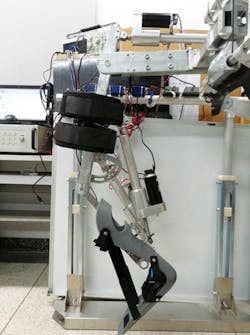Worldwide, 15 million people per year suffer from a stroke, and 85% of those who survive live with residual effects, requiring long-term intensive physiotherapy that places a huge burden on the healthcare system, according to Prof. Martin Levesley of the University of Leeds, speaking last summer at NIWeek in Austin. Robotics can help, as a project at Leeds and a separate project at Beihang University in China and Aalborg University in Denmark demonstrate.
Regarding the Leeds project, Levesley said, “We challenged our students to find new ways to deliver the extra additional therapy people need.” The result is Project ALAN (for Advanced upper-Limb Autonomous Neuro-rehabilitation), a post-stroke patient therapy device that won National Instruments’ Global Student Design Contest. Team member Arturs Grigals, a mechatronics and robotics student, said at NIWeek, “Project ALAN is all about getting patients to relearn to use their arms independently in a time and place that suits them.” The goal is a commercially viable device that patients can use in their homes in conjunction with traditional therapy. So far, the team has built the rehabilitation device itself, called myPAM, as well as a humanoid arm, called ALAN-Arm, that acts as a robotic test system for myPAM. myPAM provides levels of assistance that vary automatically over time as a patient recovers.
The project made use of a variety of NI software (LabVIEW, LabVIEW Real-Time Module, LabVIEW FPGA Module, LabVIEW myRIO Toolkit, LabVIEW PID and Fuzzy Logic Toolkit, LabVIEW SoftMotion Module, and DIAdem) as well as hardware (including myRIO and cRIO).
Lower-limb exoskeleton
While Project ALAN focuses on the upper arm, researchers from Beihang University in China and Aalborg University in Denmark have designed a lower-limb robot exoskeleton that features natural knee movement to improve patients’ comfort and willingness to wear it for gait rehab.
Courtesy of Beihang University
The robotic exoskeleton, compatible with the human knee joint, is intended to help stroke patients regain their physical fitness, aid the rehabilitation training of paralyzed patients, or assist those who need help performing daily activities. The researchers have presented a paper1 explaining that the exoskeleton has a “… hybrid serial-parallel kinematic structure consisting of a 1-DOF hip joint module and a 2-DOF knee joint module in the sagittal plane.” The design’s planar 2-DOF parallel mechanism accommodates the motion of the human knee joint, which features rotation and relative sliding.
Weihai Chen, a professor at Beihang University’s School of Automation Science and Electrical Engineering in Beijing and one of the coauthors of the paper, elaborated on the 2-DOF approach. “Our new design features a parallel knee joint to improve the bio-imitability and adaptability of the exoskeleton,” he said in a press release. He emphasized the importance of “movement transparency”—that exoskeleton movement should be synchronized and consistent with a patient’s natural movement. “If not, it exerts extra forces on the human joint,” he said. “And this extra force causes patient discomfort and unnatural movements.” Indeed, he said, “Our design goes beyond solving the transparency problem in the knee joint—and it’s a simple structure. Unlike most previous exoskeletons, which simplified the knee joint as a pin joint, ours provides 2 DOF to make the exoskeleton’s movement consistent with a patient’s natural movement.”
The researchers’ paper includes the results of cosimulations using MATLAB from MathWorks and Adams from MSC Software that demonstrate the feasibility of their design. They also have built a prototype (see image) to verify their kinematic analysis.
The researchers are developing virtual-reality games to try to make the rehab process more enjoyable. (The Leeds team’s demo at NIWeek featured a virtual worm devouring virtual apples.) Chen and his team also are exploring controlling the exoskeleton via a patient’s electromyography (EMG) and EEG signals. More immediately, Chen said, “We’d also like to commercialize it in the near future, so we’ll be working to make the robot’s appearance fancier and enhancing the user interface to be more user friendly.”
Reference
- Lyu, Mingxing, et al., “Design of a biologically inspired lower limb exoskeleton for human gait rehabilitation,” Review of Scientific Instruments, AIP Publishing, Oct. 25, 2016.
About the Author

Rick Nelson
Contributing Editor
Rick is currently Contributing Technical Editor. He was Executive Editor for EE in 2011-2018. Previously he served on several publications, including EDN and Vision Systems Design, and has received awards for signed editorials from the American Society of Business Publication Editors. He began as a design engineer at General Electric and Litton Industries and earned a BSEE degree from Penn State.

